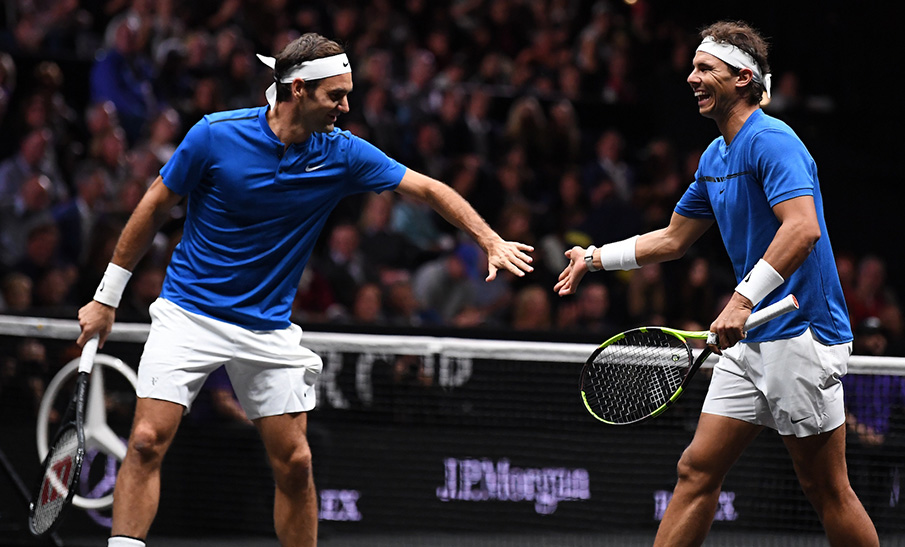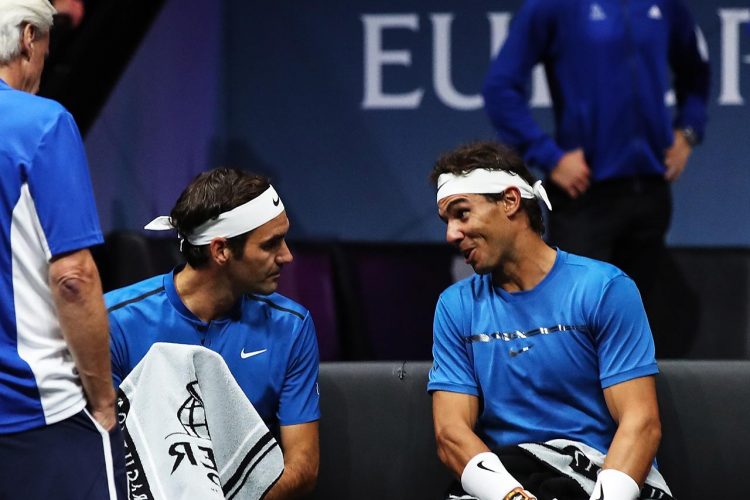
It’s hard to imagine a bigger boost for doubles! The world’s top two players, the greatest active legends in the sport, teamed up to play a delightful match, Roger Federer and Rafael Nadal edging out Sam Querrey and Jack Sock 6-4 1-6 10-5 to give Europe a 9-3 lead after day two of the Laver Cup.
Just how much history will be made this weekend won’t be clear for a while, but this was the kind of match that is hardly ever seen. It’s not known for certain whether the top- and second-ranked players have ever played doubles together – if they have, it’s very rare and certainly hasn’t happened for a while, possibly not since the early days of the computer rankings in the mid-1970s.
It’s definitely the first time Federer and Nadal have teamed up outside exhibitions, and it brought out the kind of match that’s normally only seen at the Olympics and select Davis Cup ties. If the big names played doubles like this, there would be no questions about doubles’ future.
Never has a bench had so many laurels on it. When Federer and Nadal sat down at changes of ends with their captain Bjorn Borg, the three could boast a staggering 46 Grand Slam singles titles between them. They also brought their own individual auras to a scratch pairing that was always going to be tough to topple.

Yet it was far from a given that they would gel as a team. Both are essentially deuce court players, but in a discussion with Borg and Europe’s vice-captain Thomas Enqvist two hours before the match, they agreed Nadal would play in the advantage court by dint of being the left-hander of the pair.
And while they did their high-fives between points and consulted regularly, sometimes the competitive instinct was just too great for cooperation. In the sixth game, the Americans lobbed, Federer called “mine”, but both he and Nadal went for it. It was Federer who blinked first, ducking dramatically at the last minute as Nadal backpedalled to hit an overhead winner. The crowd loved it, even though the legends had come close to tennis’s version of mutual self-destruction.
The whole match exuded an enormous sense of fun, without the competitive element ever diminishing. The Americans deserve their share of the credit, Sock especially, for while Querrey was solid and generally the bigger server, Sock was the driving force, regularly finding the gaps between the two Europeans and forcing reflex volleys with some explosive forehands.
With the first two games going to love, and just three points against the serve in the first four, the match looked ripe for a couple of tiebreaks. But in the seventh game Sock double-faulted on break point, and the Europeans were away. They had to save three break points in the following game as the level of improvised tennis went up and up, but they eventually wrapped up the first set in 40 minutes.
When Nadal was broken in the fourth game of the second set, the balance shifted, and the legendary pairing started to look somewhat ragged. By contrast Sock played his best tennis of the match, and a second break allowed the World to take the set 6-1.

Yet from the very start of the super tiebreak, Federer and Nadal tapped into their champions’ qualities. They played the first couple of points with renewed focus, drew some errors from the otherwise admirable Sock, and were out of sight before the Americans realized what had hit them. The 10-5 score speaks well for Sock’s and Querrey’s resilience as they were 8-1 adrift at one stage, but against Federer and Nadal there was never going to be a way back from that deficit.
So has this started a trend? It seems not. While Nadal described the experience as “an unforgettable day”, and Federer talked about it being “an absolute pleasure” to play alongside Nadal, both men left the strong impression that this was a one-off. “After being rivals for so many years, to be in the same part of the court fighting for a team is something special,” said Nadal, while Federer said he’d enjoyed “seeing his [Nadal’s] thought processes and knowing I could trust him on the big points.”
Yet when it came to whether they would play together again, Federer said they had agreed to give camera teams unprecedented access to their preparation and team meetings, specifically because this was a once-in-a-career opportunity. “We’re essentially singles players who play a bit of doubles,” he said, “and I don’t think that’s going to change.”
It makes the experience of having seen the great rivals teaming up in Prague all the more precious.